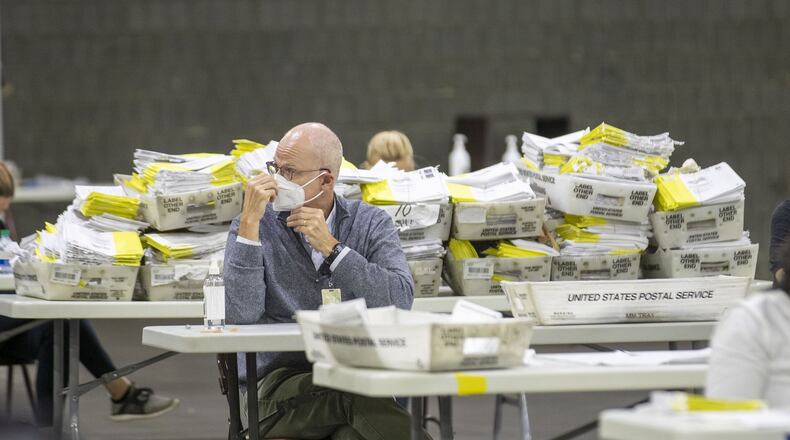Never before have so many Georgia voters decided to cast absentee ballots, voting from the convenience of their homes and avoiding polling places during the coronavirus pandemic.
The influx of so many new absentee voters has led to many questions about how it works.
Here are answers to some of the most common questions about absentee voting in Georgia:
Q: Who can vote by mail in Georgia?
A: All registered voters are allowed to request and cast absentee ballots. No reason or excuse is required to vote absentee under a state law passed in 2005. Georgia is one of 35 states where any voter can request an absentee ballot. Nine other states automatically send mail-in ballots to all voters.
Q: How do I request an absentee ballot?
A: A new website allows voters to order an absentee ballot: ballotrequest.sos.ga.gov. Voters can also print out and return a paper absentee ballot application from the secretary of state’s website. In addition, many Georgians received mail from outside organizations that included absentee ballot request forms, which can also be returned to county election officials.
Q: How do I fill out my absentee ballot?
A: Use blue or black ink to completely fill in ovals next to candidate names. Do not use red ink or felt tip pens, which could result in votes not being scanned. Mark only one choice per race.
Q: Why are so many people suddenly voting absentee?
A: After the coronavirus hit last spring, Secretary of State Brad Raffensperger mailed absentee ballot application forms to 6.9 million Georgia voters. He encouraged voters to fill out their ballots at home as a way to avoid the risk of exposure to the virus at in-person polling places.
Voters responded to the program, resulting in a record 1.15 million absentee ballots in the state’s primary, accounting for nearly half of all votes cast. Raffensperger didn’t repeat the mailings again for the general election, citing the multimillion-dollar cost.
Instead, he launched the ballotrequest.sos.ga.gov website and continued to promote voting in advance of Election Day. The site allows Georgians to obtain an absentee ballot in a few clicks, without the need to mail a paper form.
After voting absentee once in the primary, many voters plan to do so again. Over 1.1 million people had requested absentee ballots for the general election through Wednesday.
Q: I’m a registered voter, but I can’t request an absentee ballot through the state’s website. It says “No match was found on the information entered or you are not a registered voter in active or inactive status. Please try again.” What should I do?
A: The ballotrequest.sos.ga.gov site doesn’t work for voters whose registration information isn’t linked to their driver’s license number, which the site depends on to verify voter information. This issue might affect Georgians who originally registered using a paper form and didn’t automatically sign up to vote at driver’s license offices.
The website will also reject requests if name spellings don’t match government records. Voters should fill in only their first and last names, excluding middle names and suffixes. Voters can check their registration information on the state’s My Voter Page at www.mvp.sos.ga.gov.
When the website doesn’t work for voters, they can instead request an absentee ballot by downloading and returning a paper absentee application.
Q: When will my absentee ballot arrive?
A: Election officials began mailing absentee ballots on Sept. 15, and they should start arriving in voters' mailboxes the following week.
During the rest of the election season, voters should expect to receive absentee ballots about a week after they request them. County election officials will process absentee ballot requests as they arrive, and then it takes a few days for them to be packaged, mailed and delivered.
Q: Can I track my absentee ballot?
A: The state’s My Voter Page allows voters to see the dates their absentee application was received, issued and returned to county election offices. Tracking through the U.S. Postal Service isn’t available.
Q: What is the deadline for absentee ballots to be returned?
A: For now, absentee ballots would be counted if they’re postmarked by Election Day and received at county election offices within three days afterward, according to a judge’s ruling. However, the secretary of state’s office is appealing that decision and seeking to reinstate a state law that sets the deadline at 7 p.m. on Election Day.
To be safe, voters should return their absentee ballots well in advance of Election Day, minimizing the chance that their ballots would be rejected if they’re received too late.
Q: How can I plan for potential delays with the mail?
A: The U.S. Postal Service recommended that voters request their absentee ballots at least 15 days before Election Day and mail them back at least a week before Election Day. That means ballots should be in the mail by Oct. 27.
Q: Do I have to use the mail to return my absentee ballot?
A: Many counties have installed drop boxes where voters can return their absentee ballots, without having to rely on the Postal Service. Absentee ballots will be counted if they’re inserted into drop boxes by 7 p.m. on Election Day.
Absentee ballot drop boxes must be located on government property and monitored by video cameras for security, according to a rule the State Election Board approved in April. They also must be securely fastened and built with a slot that prevents ballot tampering, damage or removal.
Q: Can election officials begin counting absentee ballots before polls close for in-person voters?
A: No absentee ballots can be counted until polls close on Election Day. However, a rule passed by the State Election Board this summer allows county election officials to begin processing absentee ballots two weeks and a day ahead of time.
The rule will give local election officials a head-start on the time-consuming process of opening, verifying and scanning a large number of absentee ballots. No votes will be allowed to be tabulated by election computers until after polls close Nov. 3.
Q: Will absentee ballots come with a return envelope?
A: Absentee ballots should be returned in a white inner envelope that will be included with voting materials that arrive at homes. The envelope was inadvertently replaced with a folded piece of paper before the primary, but that issue has been corrected.
Voters must place the inner envelope inside the mailing envelope. Voters are required to sign an oath on the outer envelope affirming that they’re eligible voters.
Q: How do I know absentee ballots will be counted?
A: Absentee ballots are counted by optical scanners, just like in-person ballots printed by Georgia’s voting computers. The difference with absentee ballots is they’re filled out by hand rather than machine.
Voters need to fill in at least 10% of the ovals next to the names of the candidates of their choice for their vote to register, according to a State Election Board rule approved this month. Check marks or X’s outside ovals might not be recorded.
Q: Can I decide to vote in-person after requesting an absentee ballot?
A: Voters who show up at polling places after ordering an absentee ballot must go through a process before they can vote in person.
If voters bring their absentee ballots with them to the polls, a poll worker can cancel it and then allow them to vote.
For those who don’t have their absentee ballots with them, poll workers have to call county election offices to ensure the voter hasn’t already returned an absentee ballot. Then the voter has to sign an affidavit and the poll worker has to cancel the absentee ballot before they can vote in person.
About the Author
Keep Reading
The Latest
Featured





